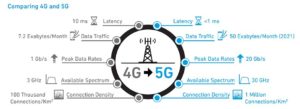On our sister site PartisanIssues.com we recently wrote The Rational Case Against Huawei . We provided a simplified explanation of the different generations of networks:
While 5G (meaning 5th Generation) is technically nothing more than the next iteration on 4G (4th Generation) cellular networks, it is in fact quite transformative. As you can see in the chart to the right:
1G is basic cellular connectivity for voice calls
2G added texting
3G added basic internet data
4G added high speed internet data
5G will be 20 times faster than 4G, will be 75 times more responsive (latency)That description of 5G specs means that it will enable hundreds of millions of devices (think, cars, ovens, thermostats and sensors of every kind) to be connected.
What we did not detail were the dramatic differences between 5G and 4G… so lets clear that up now:
 5G will be 10 to 20 times faster than 4G enabling us to do things we have not even thought of yet
5G will be 10 to 20 times faster than 4G enabling us to do things we have not even thought of yet- 5G will connect (latency) 5 to 10 times faster than 4G allowing real time remote control of vehicles and other time sensitive systems
- 5G will allow 10 times that number of devices to connect from the same location without interfering with each other
- 5G will have 3 times more efficient use of antennas compared to 4G
- 5G will consume up to 100 times less energy than a comparable 4G network
| 4G | 5G | |
| Speed | 1Gb/s | 20Gb/s |
| Latency | 10ms | 1ms |
| Density – Devices per Square Kilometer | 100,000 | 1 Milion |
| Max Data Traffic per Month | 7 Exabytes | 50 Exabytes |
| Frequency | 2 – 8 Ghz | 3 – 300Ghz |
| Fixed Antenna Range | 1 – 2 Kilometers | 250 -300 Meters |
| Mobile Antenna Range | 50 – 150 Kilometers | 50 – 80 Kilometers |



0 Comments